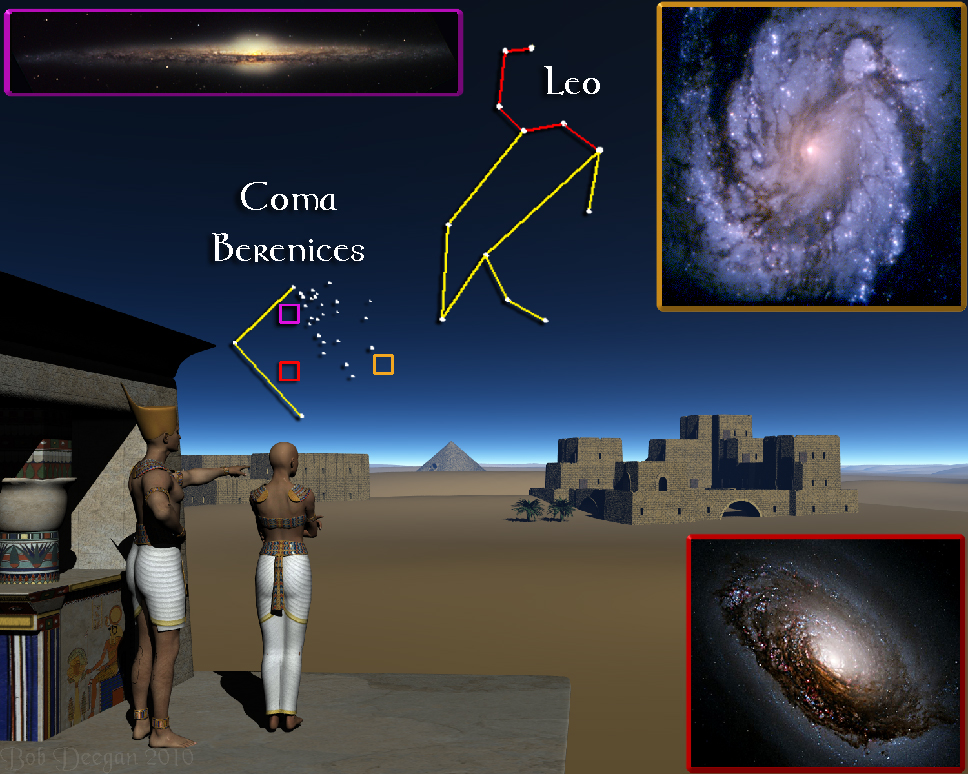
For the week including March 26, 2010

BERENICE'S HAIR
Looking to the east in the early evening, you will see the bright star Deneb marking the tail of Leo, the Lion, near the horizon. Just to the left of it is the constellation known as Coma Berenices, composed of three primary stars with a faint spray of distant companions. The constellation’s origin dates back thousands of years and to a royal family of ancient Egypt. In 246 BC, the queen, Berenice, was famous for her fabulous head of hair and the love she had for her king, Ptolemy III. When Ptolemy went off to fight in a war against Syria, Berenice made a very public promise to sacrifice her hair to the gods if they would return her husband to her in one piece. As things turned out, Ptolemy, after great victories, did come back and the queen fulfilled her promise by shaving her head. Berenice placed her hair on the altar of Aphrodite while an adoring crowd went wild. Everything was fine until, one night, the hair vanished from the altar. The next day, an angry mob demanded that the priests of the temple explain the missing sacrifice and the appearance of some pretty familiar-looking hair in the wig maker’s salon. Things looked bad at the temple until a priest pointed up in the sky and announced that the gods liked Berenice’s hair so much that they had placed it among the stars. To the priest’s amazement and relief, the crowd went for it hook, line and sinker. Today, that area of sky is known as the constellation Coma Berenices -- Berenice’s Hair.
Although the stars of Coma Berenices aren’t very bright, it’s worth an exploration. You can see Berenice’s hair as a faint spray of stars near the end of the constellation. Before they were reassigned, these stars represented the tuft at the end of Leo’s tail. On a clear dark night look for these deep-sky objects with binoculars or a telescope:
M100: This is one of the finest grand design spiral galaxies available to amateur stargazers with a telescope of medium size. Because it’s oriented face-on toward Earth, we get a great view of M100’s two vast curving arms of stars. The prominent bluish regions are filled with hot, brilliant young stars. The Hubble Space Telescope photograph in our illustration shows just the core area of the galaxy -- click on it to get an idea of the whole galaxy.
NGC 4565: A visit to this constellation wouldn’t be complete without seeing this, surely the most beautiful of the galaxies seen edge-on from Earth. Viewed through a backyard telescope NGC 4565 looks like an ethereal, luminous ball pierced by a needle of light. Many astronomers believe that this is how our Milky Way galaxy would appear if we were able to look back at it from a distant point in space.
M64: Nicknamed “The Black Eye Galaxy”, M64 shows two galaxies that have not quite finished merging into one. The Hubble Space Telescope photograph in our illustration shows the dark dust lane that earned M64 its moniker. It results from the original galaxies’ opposite directions of rotation. Even now, the inner region of M64 spins in one direction while the rest of the galaxy revolves around it going the other way.
NGC 4565 photo credit: Bruce Hugo and Leslie Gaul/Adam Block/NOAO/AURA/NSF
Unless otherwise indicated, all content of this web site is the copyright of Robert Deegan and all rights are reserved.
For more information, or to comment, please contact: Bob@NightSkies.org